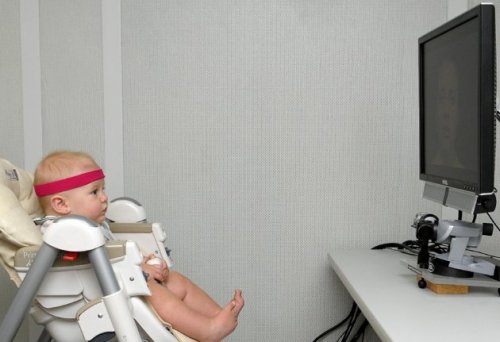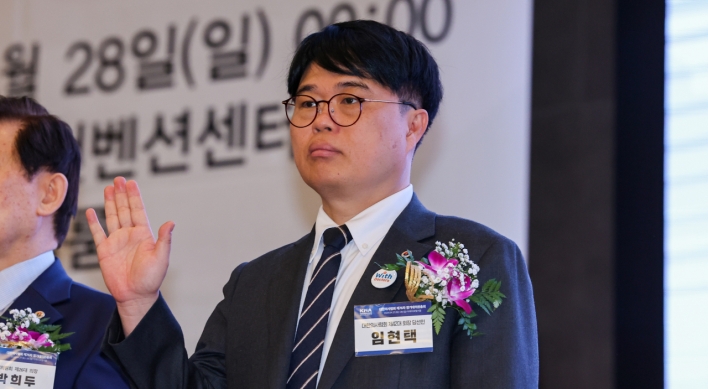WASHINGTON (AP) — Babies don't learn to talk just from hearing sounds. New research suggests they're lip-readers too.
It happens during that magical stage when a baby's babbling gradually changes from gibberish into syllables and eventually into that first "mama" or "dada."
Florida scientists discovered that starting around age 6 months, babies begin shifting from the intent eye gaze of early infancy to studying mouths when people talk to them.
"The baby in order to imitate you has to figure out how to shape their lips to make that particular sound they're hearing," explains developmental psychologist David Lewkowicz of Florida Atlantic University, who led the study being published Monday. "It's an incredibly complex process."
Apparently it doesn't take them too long to absorb the movements that match basic sounds. By their first birthdays, babies start shifting back to look you in the eye again — unless they hear the unfamiliar sounds of a foreign language. Then, they stick with lip-reading a bit longer.
"It's a pretty intriguing finding," says University of Iowa psychology professor Bob McMurray, who also studies speech development. The babies "know what they need to know about, and they're able to deploy their attention to what's important at that point in development."
The new research appears in this week's issue of the Proceedings of the National Academy of Sciences. It offers more evidence that quality face-time with your tot is very important for speech development — more than, say, turning on the latest baby DVD.
It also begs the question of whether babies who turn out to have developmental disorders, including autism, learn to speak the same way, or if they show differences that just might provide an early warning sign.
Unraveling how babies learn to speak isn't merely a curiosity. Neuroscientists want to know how to encourage that process, especially if it doesn't seem to be happening on time. Plus, it helps them understand how the brain wires itself early in life for learning all kinds of things.

Those coos of early infancy start changing around age 6 months, growing into the syllables of the baby's native language until the first word emerges, usually just before age 1.
A lot of research has centered on the audio side. That sing-song speech that parents intuitively use? Scientists know the pitch attracts babies' attention, and the rhythm exaggerates key sounds. Other studies have shown that babies who are best at distinguishing between vowel sounds like "ah" and "ee" shortly before their first birthday wind up with better vocabularies and pre-reading skills by kindergarten.
But scientists have long known that babies also look to speakers' faces for important social cues about what they're hearing. Just like adults, they're drawn to the eyes, which convey important nonverbal messages like the emotion connected to words and where to direct attention.
Lewkowicz went a step further, wondering whether babies look to the lips for cues as well, sort of like how adults lip-read to decipher what someone's saying at a noisy party.
So he and doctoral student Amy Hansen-Tift tested nearly 180 babies, groups of them at ages 4, 6, 8, 10 and 12 months.
How? They showed videos of a woman speaking in English or Spanish to babies of English speakers. A gadget mounted on a soft headband tracked where each baby was focusing his or her gaze and for how long.
They found a dramatic shift in attention: When the speaker used English, the 4-month-olds gazed mostly into her eyes. The 6-month-olds spent equal amounts of time looking at the eyes and the mouth. The 8- and 10-month-olds studied mostly the mouth.
At 12 months, attention started shifting back toward the speaker's eyes.
It makes sense that at 6 months, babies begin observing lip movement, Lewkowicz says, because that's about the time babies' brains gain the ability to control their attention rather than automatically look toward noise.
But what happened when these babies accustomed to English heard Spanish? The 12-month-olds studied the mouth longer, just like younger babies. They needed the extra information to decipher the unfamiliar sounds.
That fits with research into bilingualism that shows babies' brains fine-tune themselves to start distinguishing the sounds of their native language over other languages in the first year of life. That's one reason it's easier for babies to become bilingual than older children or adults.
But the continued lip-reading shows the 1-year-olds clearly still "are primed for learning," McMurray says.
Babies are so hard to study that this is "a fairly heroic data set," says Duke University cognitive neuroscientist Greg Appelbaum, who found the research so compelling that he wants to know more.
Are the babies who start to shift their gaze back to the eyes a bit earlier better learners, or impatient to their own detriment? What happens with a foreign language after 12 months?
Lewkowicz is continuing his studies of typically developing babies. He theorizes that there may be different patterns in children at risk of autism, something autism experts caution would be hard to prove.
<한글기사>
'아기 입술모양 보고 말 배운다'
유아용 DVD 틀기 보다 아기와 얼굴 맞대고 얘기해야 말 빨리 배워
아기들은 단지 음성만으로 말을 배우는 것이 아니라 입술 모양을 보고서도 언어를 습득한다는 새 연구결과가 나왔다.
이는 아기의 옹알이가 잘 알아들을 수 없는 단계에서 음절로 점차 변화해 마침내 처음으로 '엄마', '아빠'라고 부를 때의 마술적 단계에서 일어난다.
미국 플로리다주의 과학자들은 생후 6개월 정도부터 아기들이 초기 유아단계의 눈맞춤 단계를 벗어나 사람들이 자신들에게 말을 걸 때 입 모양을 유심히 관찰한다는 사실을 밝혀냈다.
플로리다 애틀랜틱대학의 발달 심리학자인 데이비드 레브코위츠는 "아기가 당신을 흉내내기 위해서는 자신들이 듣는 특정 발음을 하기 위해 입술을 어떻게 움직여야 하는지를 파악할 필요가 있다.
이는 믿기지 않을 정도로 복잡한 과정이다"고 말했다. 레브코위츠는 이번 연구 논문의 주저자다.
아기들이 기초 발음과 어울리는 입술의 움직임을 파악하는 데는 그리 오랜 시간이 걸리지 않는 것처럼 보인다.
왜냐하면 아기들이 첫돌을 맞을 쯤이면 다시 입술 모양 관찰보다 어른들과 눈맞춤으로 행동을 옮기기 시작하기 때문이다. 단, 외국어 같은 익숙지 않은 소리를 들을 때는 예외다. 이때는 아기들이 입술 관찰을 좀 더 오래한다.
아이오와대학의 심리학 교수인 밥 맥머레이는 "매우 흥미진진한 발견이다. 아기들은 자신들이 알아야 할 필요가 있다는 것을 알고는 특정 발달 단계에서 중요한 것에 주의력을 집중할 수 있다"고 언급했다.
금주 '미 국립과학원회보'(PNAS)에 게재되는 이번 연구는 아기와 얼굴을 마주하는 양질의 시간이 언어 발달에 매우 중요하다는 기존 증거를 보강해준다. 다시 말해 최신 유아용 DVD를 틀어주는 것보다 더 중요하다는 얘기다.
이번 연구는 또 자폐증을 포함해 발달장애가 있는 아기들의 경우 똑같은 방식으로 말을 배우는지, 혹은 이들이 초기 경고성 징후를 제공할 만한 차이점을 보이는지 에 대한 의문을 제기한다.
아기들이 말하는 법을 밝혀내는 것은 단순히 호기심 차원에 머무르지 않는다.
신경과학자들은 특히 아이의 말하기가 더딜 때 이 과정을 촉진시키는 법을 알아내고자 한다. 또한 뇌가 생애 초기 단계에서 모든 사물을 파악하기 위해 어떻게 스 스로 신경망을 연결시키는지 이해하는데도 이 연구는 도움이 된다.
플로리다 연구진은 180명에 가까운 아기들을 생후 4, 6, 8, 10, 12 개월별 그룹 으로 분류한 뒤 영어권 아기들에게 여자가 영어와 스페인어를 말하는 화면이 담긴 비디오를 보여줬다.
이때 부드러운 머리띠에 부착된 기기를 통해 각 아기의 응시가 어디에 집중되고 얼마나 오래 지속되는가를 관찰한 결과, 놀랍게도 화자가 영어를 쓸 때 4개월 된 아 기들은 대부분 그녀의 눈을 빤히 쳐다본 반면 6개월 된 아기들은 동일한 시간을 눈과 입술을 바라보는 데 썼다. 또 8개월, 10개월 된 아기들은 대부분 입술만을 관찰 했고 돌을 맞은 아기들은 주의를 다시 화자의 눈으로 돌렸다.
레브코위츠는 "생후 6개월이 될 때 아기들이 입술 움직임을 관찰하기 시작한다 는 것은 자연스럽다"면서 "왜냐면 이때 아기들의 뇌가 소리에 자동 반사하기보다 주 의력을 통제하는 능력을 갖기 때문"이라고 설명했다.
한편 영어에 익숙해진 아기들에게 스페인어를 들려줬을 때 12개월 된 아기들은 더 어린 아기들처럼 입을 더 오래 관찰했다. 익숙하지 않은 소리들을 해독하느라 보 충 정보가 필요했기 때문이다.
이는 아기들의 뇌가 생후 1년 기간에 모국어와 외국어 소리를 분별하기 시작하기 위해 스스로 미세 조정한다는 2개국어 상용 연구 결과와 맞아떨어진다. 아기들이 더 나이가 많은 어린이나 어른들보다 2개국어 습득 능력이 더 쉽다는 이유도 여기에 기인한다.







![[Music in drama] Rekindle a love that slipped through your fingers](http://res.heraldm.com/phpwas/restmb_idxmake.php?idx=644&simg=/content/image/2024/05/01/20240501050484_0.jpg&u=20240501151646)



![[New faces of Assembly] Architect behind ‘audacious initiative’ believes in denuclearized North Korea](http://res.heraldm.com/phpwas/restmb_idxmake.php?idx=644&simg=/content/image/2024/05/01/20240501050627_0.jpg&u=20240502093000)






